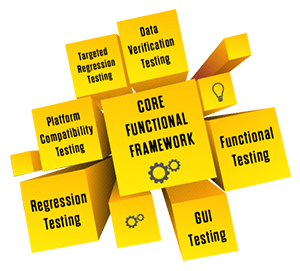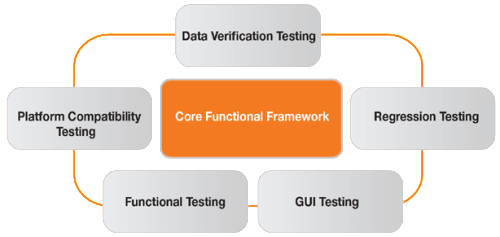Discover the five key aspects that lead to success in the functional testing of your software.
Introduction to Functional Testing
What is the first thing companies developing software do when going after market share? Develop a minimum viable product (MVP). Then, they start piling on features and functions to keep up with or surpass their competition. Soon, as their features and functions begin to grow, they realize that they can’t test everything and must use test automation in some way. There are just too many functions, and using them in various combinations becomes complex.
That’s why, when it comes to functional testing, strategically designing test cases is so important. XBOSoft has been fortunate over the last 15 years to have gained the expertise and experience in this domain. As a result, we’ve focused our entire company on software quality and software testing, where functional testing is at the heart of our business. Based on our experience, some of the key aspects that lead to success in functional testing include:
1. Careful Design of Test Cases
Design test cases carefully using the typical methods such as equivalence, boundary, negative, etc. but pay particular attention to labeling to pick out what test cases you need to execute for specific instances. For example, you may want to test all functions related to reporting or a particular set of calculations. Can you easily pull these out and execute them?
2. Use Combinatorial Methods
This will help reduce the number of platforms you need to test. For more information on how to strategically approach platform compatibility testing, read this blog.
3. Make Defects an Analytical Tool
Use defects as a key method to analyze where you need to focus more on testing and test case granularity. Some functions are just plain complicated and have complex logic, or they may be intertwined with many other parts of the software. This is where defects tend to propagate and concentrate. Examine defect density in your software’s functional areas to lead to better test case design and more thorough functional testing where you need it. Defect management tools such as Jira enable you to categorize, slice, and dice defects so that you can analyze them. Use some of the advanced labeling and workflow features of Jira to create your own ‘big data’ to drive your decisions.
4. Use Automation Sparingly at First
Our mantra at XBOSoft is that “You can’t automate what you don’t understand”. After several rounds of manual testing, then, and only then, will you grasp what areas of the software are most suited for test automation. Furthermore, at that point, your application will reach a maturity level where changes may not be occurring on a daily and weekly basis such that test automation makes sense.
5. Test as an End-User
It’s easy to dig deep into every function and every feature, but more important is to think about how the end-user will use the software as a whole, going from one function to the next in their daily work. Design these holistic or integration test cases as soon as you can. Talk to end-users about what top 3 tasks they work on every day.
XBOSoft continues to push Automated Mobile Functional Testing across Mobile MedSoft’s Healthcare mobile apps…
BY PHILIP LEW
Why functional testing is important
The functional testing market in the software testing services space continues to grow and will for the foreseeable future. The methods of doing functional testing may change however over time as machine learning and artificial intelligence make strides in their algorithms, but from what we have seen, they still have some distance to cover.
Illustration
For example, when you think about autonomous vehicles, why is it taking so long to become a safe and prevalent means of transportation? One reason is legal barriers of course, but another main barrier is that the variations and permutations of different situations or user scenarios and contexts are endless and there is always something new and different. This makes it hard to learn everything even if you have infinite learning capacity via storage and computing power. So even with all the computing power in the world and all the data for learning, it still makes sense to apply typical old-fashioned common sense to test design. So many of the common techniques such as boundary value analysis, edge case, equivalence partitioning, combinatorial modeling, and negative testing still apply. In fact, many AI algorithms use these methods as part of their logic and learning methods.
Conclusion
So, if you are still wondering if the functional testing market for software will continue to grow, just look around you. Software is everywhere, even where you can’t see it. And the companies that make software-related products need to test them properly, so they don’t break and remain safe and secure to use. This requires going beyond button pushing and really understanding what the users will do and what they are trying to achieve when using the software. It also involves understanding when it is best to automate, what platforms should be tested, and how to convert all of these facets into end-user acceptance tests, or regression suites that target the functions you will use the most.
Talk to us
Our clients speak out frequently on how we get deeper than their own employees and develop deep application and domain knowledge. If you need a ‘secret weapon’, as we are often called by our clients, to boost your software quality, contact us or email us at [email protected].
You can find us on:
You might also like:
 |
 |
 |
||
| Functional Testing Services | User Acceptance Testing | How to Reduce the Cost of Software Testing | ||
| By: Philip Lew | By: Philip Lew | By: Philip Lew |
The 5 Key Success Factors in Functional Testing
April 27, 2022
Most Popular
 |
A Quick Introduction To Jira
By: Jimmy Florent |
|
 |
Visual Regression Testing Market Challenges and Opportunities
By: Philip Lew |
|
 |
Agile Testing Solution Market Continues to Grow – What Are The Key Challenges?
By: Philip Lew |
|


